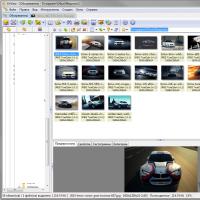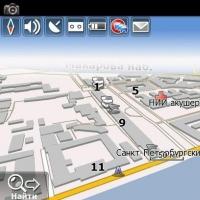How to turn off mirror mode on an iPhone. Tips for using the iPhone camera. Snapshot creation process
Hello everyone. Mobile photography is a delicate thing. It's hard to tell which takes longer to shoot or process a photo on a smartphone.
In my case, the process of processing the image is half the battle. I know people who say that processing a photo is not a natural process and should not be done. I do not agree with this, I will tell you what I think in a separate article.
I do not want to show the basic things that you already know about, but I will share some tricks and tell you how I achieved a certain effect in this or that picture. Let's go!
I had a lot of shots with the effect of mirroring. In order not to go far, take one of my photos on Instagram with mirroring opera house.
At first glance, those who have not seen the theater building think that it is really reflected in some puddle or just a body of water. In principle, this is the purpose of such processing, optical illusion. Although I am not trying to hide the fact of interference with a graphic editor.
There are also “viewers” who do not understand that the entire process of creating a photo is carried out on a smartphone from the shooting itself to post-processing.
It's clear that the same effect can be done on a DSLR camera by connecting Photoshop to work. My task is to show you what can be done with a device that fits in a jeans pocket.
Snapshot creation process
This is what the original version of the photo looks like.
Opera House in Lviv
Opens it in the Enlight app on your iPhone or iPad. First of all, it needs to be brought to normal proportions and cut from below. To do this, Enlight has a Crop tool.
The next step is to create the reflection itself. To do this, in the Crop tool, we use the Vertical function, it will rotate the photo upside down, keeping the proportions of the image.
After that, we save the photo in the device's memory. We will have two copies of the image - before and after the inverted state. I think at this stage you have already understood where we are heading.
Now we will combine both versions of the photo into one. To do this, use the "finish" section and select "collage" in it. Select the appropriate collage sketch and carefully adjust the two parts of the photo. Then, in the "Tool" tab, changes the size of the frames of the collage, setting the value to "0".
The photo is almost ready, it remains to do a re-cropping, removing the black stripes on the sides, formed by aligning during the creation of the collage.
You can stop at this or apply some kind of filter on the photo, if the picture requires it. But I prefer to make the reflection a little blurry in order to further disorient the viewer and remove the suspicion that the reflected image is too perfect.
To do this, in the "Tool" section, select the "Miniature" utility, changing the shape of the miniature to linear mode. After that, we turn the ruler 180 degrees, so that the blur effect appears on the building reflected at the bottom, or press the "inversion" button, the program will automatically change sides. Now play around with the intensity setting and increase or decrease the amount of blur. It's up to you.
That's all. The photo is ready. This was a simple tutorial that shows you how you can do something extraordinary with one smartphone app, one photo and one fantasy.
In the meantime, I am writing the next lesson on Enlight for the iPhone, you can see what other examples I created in this style were made by me in this style.
Instructions
First of all, check the connection between your webcam and your computer, and whether Skype detects it. To do this, launch the program by double-clicking on the icon on the desktop and try to call someone from your contact list. To test the volume of the voice from your microphone, press the call button for the person Echo (Skype test contact).
If you did not find the camera, go to the "Device Manager" and check for the presence of a line with the name of the webcam. To call this application, right-click on the "My Computer" icon and click on the line of the same name. If there are no installed drivers, try installing them from the disk or download them from the official website.
Then go to the program, click the "Tools" menu and select "Settings". In the window that opens, go to "Settings". In the window that appears, click on the "Webcam Settings" button.
In the settings window that opens for the picture received from the web device, find the lines Image Mirror Flip and Image Vertical Flip. Select the required option by checking the box next to this item and click the "OK" button to close the window and save the changes.
You can check the result of the changes made in the "Video settings" block. Navigate to it and look at the window that displays the status of your web device. If no changes are observed, close the program and restart it.
In some cases, it is recommended to update the webcam configuration files, this will require a reboot. Press the Power button on your keyboard and select "Restart" or use the standard computer shutdown applet in the "Start" menu. After your computer boots up, start Skype and check the changes.
Sources:
- [Solved] Image from web
Communication via Skype and a webcam has long become a habit of computer users. Connecting the Internet to a computer, installing Skype and connecting a webcam is quite simple. However, sometimes non-standard difficulties arise.
You will need
- - a computer;
- - camera;
- - drivers.
Instructions
Make sure the web is connected to your computer. You can find the webcam as a device in the "Device Manager" or in the "Computer Control Panel". Open Skype. If the camera is connected or integrated into the computer, but install special drivers. They are usually provided on disk. Can also be found on the manufacturer's official website.
Click on Tools or Tools and select the Options menu item. On the left side of the settings window, find "Settings", or Video settings and click on it with the left mouse button. In the window that appears, click on the "Webcam settings" button. The interface of this software depends on the type of default language you use.
A window with detailed settings for the image from the webcam will open. Find the item Image Mirror Flip - it uses a mirror image flip. The Image Vertical Flip item changes the image from bottom to top. Check the box you want. Click "OK" to save the settings and close the window. In the "Video Settings" section, you will see a small window where the webcam image is displayed. Check if the picture has changed in the properties window. If not, restart Skype.
It is also worth noting that you may need to restart your computer to save all the settings that were made in the Skype program. Restart your personal computer and try again to view the view under which the picture is displayed on the web. If you subsequently need to rotate the image in the other direction, you can do this in the same way. You can also view all the webcam settings in the standard menu, which depends on the type of manufacturer and supplied drivers.
Related Videos
To start virtual communication via Skype, you just need to connect to the Internet, then install the software and connect your web device to your computer.

You will need
- - a computer;
- - Webcam.
Instructions
Sometimes you need to rotate the camera, i.e. an image that is passed from one user to another. To transform the image, you must first of all check that the camera is connected to the computer correctly. You can find this device through the "Device Manager". To call it, right-click on the "My Computer" icon and select the item of the same name.
Launch Skype by double-clicking the shortcut on your desktop or Quick Launch. In the main window of the program, click on the top menu "Tools" and in the list that opens, select "Settings". In the window that opens, pay attention to the "Video Settings" block on the left. After going to this section click on "Webcam Settings".
You will see an applet for setting the displayed image. Use the Image Mirror Flip and Image Vertical Flip options to transform the screen image. Highlight the required item and left-click on the "OK" button or press Enter. There is a small element in the Video Settings window that serves as a preview. Review your changes there. If the picture on the video is displayed as it should, close the settings window.
After making changes to the program settings, it is recommended to restart it. Click the top menu "File" and select "Exit". Run the program using the shortcut and check the display of the resulting image.
In some cases, restarting the program is not a panacea for this problem. older versions of utilities of this plan require a reboot of the drivers themselves, and this can only be done after rebooting the system itself. Click the Start menu, select Shut Down and click the Restart button.
Related Videos
Virtual communication using a video camera and Skype has long been a common practice for Internet users. Installing the software and connecting a webcam is not difficult, but sometimes some questions arise, for example, if the image is upside down.

Instructions
Make sure the camera is connected to and working. Highlight the "Computer" icon, press Alt + Enter, the computer properties window will open. On the right side, click the Device Manager link. If the camera does not work, although it is connected, install the drivers that come with the device itself, or download them from the manufacturer's official website.
Skype's interface and language depends on which settings you are using. Find the "Tools" item, click on the "Options" tab, then "Video settings". In the window that opens, click the "Webcam settings" item.
In the window that opens, there will be detailed settings for images received from the webcam. The options menu depends on the camera manufacturer. Find Horizontal Flip / Image Horizontal Flip to flip the image from top to bottom, or Vertical Flip / Image Vertical Flip to flip from left to right. Save the settings - click OK, close the window. Restart Skype. In the item "Video settings" there is a small window in which the image from the camera is displayed, check if the image has changed.
You may need to restart your computer to save your settings in Skype. Reboot, see if the result is achieved. If you have changed the position of the camera and you need to return the original settings, or set new ones, do it in the same way. You can also customize the webcam image in the software in the Options / Options section or by clicking on the wrench icon.
You were eager to chat on Skype, bought a new webcam, connected it to your computer. But here's the problem: due to the peculiarities of the camera mounting, the image turned out to be inverted. Don't despair; a computer - although a complex thing, you can always configure the necessary parameters in it.

Instructions
First you need to make sure that the camera is working properly. First of all, make sure the system detects it. If not, use the software that comes with the camera, or download it from the manufacturer's official website. When the camera is detected by the system, a corresponding message will appear in the tray.
Launch the software, find the section "Settings / Options" (Options) or click on the icon with the image of a wrench. The interface and functionality of the software depends on the model and manufacturer of the camera. Set the video options you want. Perhaps in the program you will find an item responsible for displaying an image in a mirror image. Save changes by clicking OK.
As you know, one of the advantages of the iPhone over its competitors is the presence of a camera capable of producing very high-quality images. Not surprisingly, more and more owners of this smartphone refuse to carry an additional digital camera with them.
At the same time, the iPhone camera has some secrets, knowing which you can improve the quality of images, expand the possibilities.
High-speed shooting can be very useful, for example, when you are photographing a child at play. In this case, the device creates a series of images in a row, from which you can then choose the best one. For high-speed shooting, you just need to hold and hold the camera shutter button on the screen. The maximum number of frames captured in the "rapid-fire" mode can reach 25. However, the speed and quality largely depend on the device itself, on the iPhone 5s this procedure will be much better than on the iPhone 4s.
The on-screen camera grid is designed to improve convenience. It makes it easier to orient the device, it is a way to create the correct composition of the frame and avoid a cluttered horizon. In order to enable the grid, go to "Settings" → "Photo and Camera" and there enable the "Grid" option.
In some cases, the HDR mode can significantly improve the quality of the image, by increasing its saturation, changing the brightness of individual fragments. It turns on and off directly from the camera window by clicking on the "HDR" button at the top of the screen. At the same time, in the process of shooting, two frames are created at once - the original and HDR. Then we choose the best one.

The option to create two pictures at once can be disabled through "Settings" → "Photo and Camera", using the switch "Leave original". However, it is better not to do this, since the HDR mode does not always guarantee an improvement in quality, in some cases it is better to do without it.
Also be aware that high-speed shooting does not support HDR mode. Even if it was turned on, the smartphone will take pictures in normal mode. It is possible that in the future, after the appearance of faster processors, the situation will change.
The autofocus of the iPhone camera works quickly and confidently. But even he is capable of making mistakes. And if this happens, then just tap your finger on the screen on the object on which you want to focus.
If you do not just touch the screen, but hold your finger for a while, the exposure and focus will be locked. In some cases, this can help in creating creative shots.
Another action that you can do with your fingers on the screen is digital zoom. This action is performed in the same way as enlarging a web page in a browser. Just touch the screen with two fingers and slide them apart.
The wired headset supplied with the device can be used as a remote control. In this case, instead of pressing the shutter button on the screen, you can use the volume buttons on the headset. In this case, continuous shooting is also impossible.

Interestingly, the headset allows you to take snapshots from the Camera app preview, available in the multitasking pane, which opens after the Home button has been pressed twice. But this is more of a curious feature than a really useful feature. Unless you can save a little time, because there is no need to switch to the application itself.
The user has access to a cut of 8 photo filters, thanks to which you can get very unusual results, create creative pictures without resorting to post-processing of the finished photograph.
Filters are available after clicking in the lower right corner of the screen. It also serves to turn off the filter - just select the "Not selected" mode. Filters do not interfere with high-speed shooting and allow you to use the HDR-mode.
The iPhone's camera capabilities can be greatly enhanced by purchasing special accessories. Today, you can find additional equipment on sale, such as tripods and lenses, specially made for various models of Apple smartphones.

Tripods will avoid the appearance of the so-called. "Shake", while lenses will expand the capabilities of the camera. So, on sale you can find models for macro photography, "fisheye" and others. Of course, even with lenses, the iPhone won't be able to challenge DSLRs. But these devices are of a completely different class. Most, even very demanding users, will be quite happy with the results.
The most common mistake that many novice users make is overdoing it with flash. More often than not, it does not improve the frame, but hopelessly ruins it. Use it only when you really need it. For example, in the absence of normal lighting, when there is still no hope of getting a more or less high-quality picture.
In fact, the camera is for installation forward, under the cut is the conversion into a rear-view camera, i.e. adding specularity. Well, at the same time opening the camera and monitor.
I take the 3rd similar camera. I like the fact that the appearance is the same as that of the factory. The camera is fastened with an M6 nut with a grover. The set includes 6 meters of cable for connection to the monitor.
Additional Information

I originally took the first 2 with specularity and stripes, but this time I needed it without stripes, tk. it will be placed in a different plane and the strips will go up the monitor when viewed. I twisted the position of the image in my head before ordering and it seemed like I decided that not Rear, but Front would do, i.e. which looks ahead, but was still mistaken, mirroring was needed.
The monitored 4.3 "monitor was taken to the camera more than once.
Additional Information

First I decided to try to get out of the situation with the monitor, I opened it.
Additional Information

Mine turned out to be: CPU: AMT630a, EEPROM 25Q40.
There is information on the network that some monitors based on such a base can reflect the image vertically / horizontally, mine could not and in the end could not). The menu contains only standard settings for colors, language and proportions. He blew off the eeprom with a hairdryer, such a programmer: he considered the firmware.
The firmware itself is here
The firmware has lines of menu items that indicate the reflection of the image, but in fact they are not in the menu. I tried to fill in a couple of firmwares from analogs that have a reflection, one did not start at all, the second was merged from its production line 2 times larger (1024 instead of my 512), only one video input worked on it, and the menu did not appear at all, in the end I gave up I did this and decided to get into the cell.
On the side of the wire, I unscrewed the lid, everything is filled with Chinese sealant, its charm is that it does not stick to the boards and components and easily moves away from them. He took a toothpick and carefully picked it out to the camera's eeprom.
Additional Information

There are 2 unsoldered jumpers on the board, in theory, one is responsible for the appearance of stripes, the second for specularity, to turn on specularity you need to hang a snot in this place:
Additional Information

Accordingly, in order to turn it off, it will be necessary to remove it on the contrary.
For the sake of interest, I tried to close the second jumper with a screwdriver, very strong interference went across the screen, the strips did not turn on, but maybe I just closed it inaccurately) But I don't need the strips.
I will cover it back with an old domestic gray auto-sealant, I somehow covered one board with it, it just as badly adhered to it like the Chinese one).
There will be no installation, out of season) Such improvements are not vital, so I do it only when it's warm.
ps fotkal in bad light on the iron while fiddling, but the meaning seems to be clear.
upd image on the monitor (480 x 272):





 Download the new version of the archiver 7 zip
Download the new version of the archiver 7 zip Configuring Mozilla Thunderbird: How To
Configuring Mozilla Thunderbird: How To OL PORTAL - all social networks and messengers in one application
OL PORTAL - all social networks and messengers in one application Programs for communication in games
Programs for communication in games XnView free download for Windows (Russian version) Xnview help in Russian
XnView free download for Windows (Russian version) Xnview help in Russian Crashes when installing or running DirectX in certain applications
Crashes when installing or running DirectX in certain applications Navigators offline (no Internet) for Android: rating review
Navigators offline (no Internet) for Android: rating review